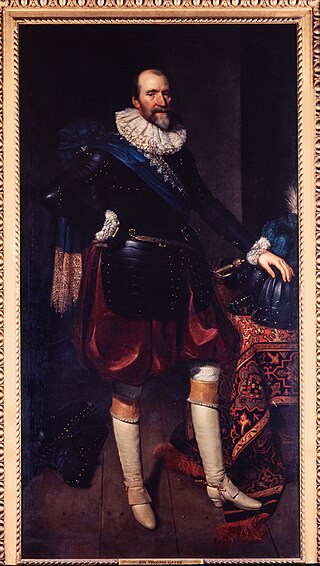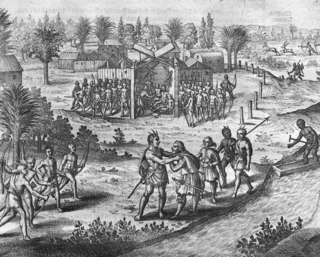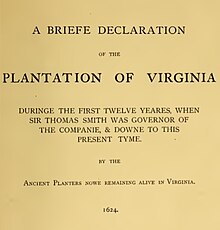
Sir George Yeardley was a planter and colonial governor of the colony of Virginia. He was also among the first slaveowners in Colonial America. A survivor of the Virginia Company of London's ill-fated 1609 Third Supply Mission, whose flagship, the Sea Venture, was shipwrecked on Bermuda for ten months, he is best remembered for presiding over the initial session of the first representative legislative body in Virginia in 1619. With representatives from throughout the settled portion of the colony the group became known as the House of Burgesses and continued to meet, becoming the Virginia General Assembly.

Sir Samuel Argall was an English sea captain, navigator, and Deputy-Governour of Virginia, an English colony.

Sir Thomas Gates was the governor of Jamestown in the English Colony of Virginia. His predecessor, George Percy, through inept leadership, was responsible for the lives lost during the period called the Starving Time. The English-born Gates arrived to find a few surviving starving colonists commanded by Percy, and assumed command. Gates ruled with deputy governor Sir Thomas Dale. Their controlled, strict methods helped the early colonies survive. Sir Thomas was knighted in 1596 by Robert Devereux, 2nd Earl of Essex for gallantry at the Capture of Cadiz. His knighthood was later royally confirmed by Queen Elizabeth I.
Elizabeth City was one of four incorporations established in the Virginia Colony in 1619 by the proprietor, the Virginia Company of London, acting in accordance with instructions issued by Sir George Yeardley, Governor. This allowed the crown to benefit from the offerings of the new land, including its natural resources, new markets for English goods, and the leverage it provided against the Spanish.
Richard Pace was an early settler and ancient planter in colonial Jamestown, Virginia. According to a 1622 account published by the London Company, Pace played a key role in warning the Jamestown colony of an impending Powhatan raid on the settlement.
Temperance Flowerdew, Lady Yeardley was an early settler of the Jamestown Colony and a key member of the Flowerdew family, significant participants in the history of Jamestown. Temperance Flowerdew was wife of two Governors of Virginia, sister of another early colonist, aunt to a representative at the first General Assembly and "cousin-german" to the Secretary to the Colony.
Edward Bennett, was an English merchant based in London, and a free member of the Virginia Company. A Puritan who had lived in Amsterdam for a period, he established the first large plantation in the colony of Virginia in North America, in what became known as Warrosquyoake Shire.

Ralph Hamor, Jr. was one of the original colonists to settle in Virginia, and author of A True Discourse of the Present State of Virginia, which he wrote upon returning to London in 1615.
William Powell, was an early Virginia colonist, landowner, militia officer and legislator. Considered an ancient planter for living in the Virginia colony during its first decade, he was one of two representatives from what became James City County, Virginia in the first Virginia House of Burgesses in 1619. His former plantation, now across the James River in Surry County, Virginia is now within Chippokes State Park.
George Thorpe, was a noted landowner, Member of Parliament, distiller, educator and major investor in early colonial companies in the Americas.

William Farrar was a planter, lawyer, real estate investor and politician in colonial Virginia who served on the Virginia Governor's Council. A subscriber to the third charter of the Virginia Company, Farrar immigrated to the colony from England in 1618. After surviving the Jamestown massacre of 1622, Farrar moved to Jordan's Journey. In the following year, Farrar became involved in North America's first breach of promise case when he proposed to Samuel Jordan's widow, Cecily, who was allegedly engaged to another man. In 1624, the case was dropped, and Farrar and Cecily married.
John Ferrar was a London merchant and brother of Nicholas Ferrar the Younger. The son of Nicholas Ferrar the Elder, he was deputy governor and treasurer of the Virginia Company of London under Edwin Sandys.
Cecily Jordan Farrar was one of the earlier women settlers of colonial Jamestown, Virginia. She arrived in the colony as a child in 1610 and was established as one of the few female ancient planters by 1620. After her husband Samuel Jordan died in 1623, Cecily obtained oversight of his 450-acre plantation, Jordan's Journey. In the Jamestown Muster of 1624-1625, she is one of fewer than ten women mentioned as a head of household and the only woman listed as sharing the head of household with a man she was not married to. In the year of Samuel Jordan's death, she set off the first breach of promise lawsuit in English North America when she chose the marriage proposal of William Farrar, who was bonded to help settle her estate, over that of Greville Pooley, who claimed his proposal had already been accepted. In 1625, Cecily prevailed when Pooley withdrew his claim. Afterward, she married William Farrar.
Samuel Sharpe, sometimes referred to as Samuel Sharp or "Ssamuel" was an early Virginia colonist who settled in the area that became Charles City County, Virginia. He came to Virginia in 1610 with most of the passengers and crew of the Sea Venture as they made their way to the colony after 10 months in Bermuda. They had wrecked in a storm there and built two small boats to complete their journey to Jamestown. Along with Samuel Jordan, he represented Charles City as a burgess in the first general assembly of the Virginia House of Burgesses in Jamestown, Virginia in 1619. He was a representative for Westover, an incorporation of Charles City, in the 1623/24 assembly and signed a letter along with several burgesses at the time of that assembly.
William Spence was an early Virginia colonist on Jamestown Island. He was member of the first assembly of the Virginia House of Burgesses in Jamestown, Virginia in 1619. Spence became an ensign in the local militia and is thus sometimes identified as Ensign William Spence or Ensign Spence. He was an early farmer on Jamestown Island, a tobacco taster and landowner at Archer's Hope. He, his wife and his young daughter, Sara, or Sarah, avoided the Indian massacre of 1622, but Spence and his wife were reported "lost" at the census of February 16, 1624.
William Spencer was an early Virginia colonist on Jamestown Island, who was an Ancient planter and a member of the Virginia House of Burgesses in Jamestown, Virginia for Mulberry Island in 1632/33.
Captain Robert Beheathland in St Endellion, Cornwall, England, was an English gentleman who arrived in Jamestown, Virginia, in 1607 aboard one of the three founding ships, likely the Susan Constant. He is noteworthy as the only original 1607 Jamestown colonist having documented descendants living today.
This is a timeline of events related to the settlement of Jamestown, in what today is the U.S. state of Virginia. Dates use the Old Style calendar.







